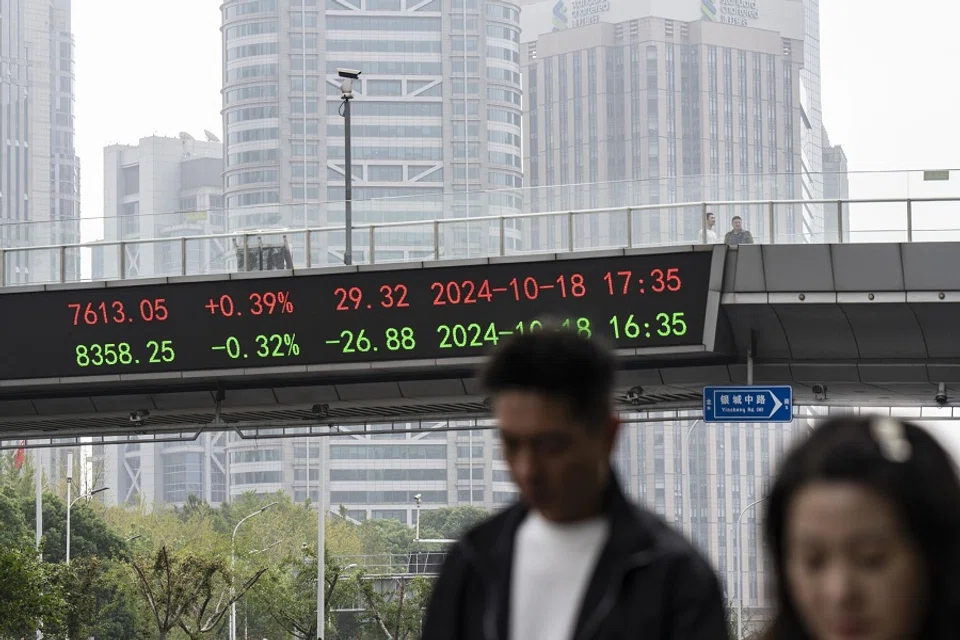Amid the Chinese government’s recent stimulus package, the Chinese and Hong Kong stock markets have temporarily escaped the three-year slump. However, Lianhe Zaobao journalist Liu Sha notes that opinions are divided on whether to double down, cash out or hold one’s position in the Chinese stock market.

At the end of September, China introduced its most aggressive monetary easing policy since the pandemic, boosting both the Chinese and Hong Kong stock markets. The Hong Kong Hang Seng Index and the Shanghai Composite Index both rose by over 20% within two weeks, reaching their two-year peak.
And so, in the first week of October, 34-year-old Li Meiru (pseudonym), who had refrained from checking her stock trading app for a long time, sold off a Hong Kong stock she had held for over three years.
In the latter half of 2020, Li became optimistic about the development of Chinese internet companies and invested in the stocks of Hong Kong-listed Tencent and Alibaba via a local Singapore trading platform. “But the stocks fell sharply right after I bought them. I deliberately avoided checking on them until the news reported a significant surge, which finally gave me the chance to break even,” she said.
During the recent surge, the Tencent shares held by Li, a product operations employee at an internet company, hit an annual high of HK$477.60 (US$61.43) per share. “My holding cost was about HK$460 per share, and I eventually sold it at around HK$470,” Li shared.
… since the beginning of the year, Singaporean investors holding offshore Chinese investments, particularly Hong Kong stocks, have benefited from the upward trend in some internet companies, financial firms and state-owned enterprises (SOEs).
Many Singaporean investors were also drawn to this stock market surge. Data from Singapore online stock trading platform Moomoo showed that from 24 September — when the Chinese government announced the first round of stimulus measures — to 9 October, the number of Moomoo users trading Hong Kong stocks in Singapore was three times more than that of the period from 1 September to 23 September; trading volume also increased by nearly seven times.
During the same period, the number of customers trading China A-shares also increased to three times that of the period from 1 September to 23 September, while trading volume nearly doubled.

Hugh Chung, chief investment advisory officer at Singapore-based investment platform Endowus, told Lianhe Zaobao that since the beginning of the year, Singaporean investors holding offshore Chinese investments, particularly Hong Kong stocks, have benefited from the upward trend in some internet companies, financial firms and state-owned enterprises (SOEs).
Optimistic about consumer sector
Since 2021, Chinese stocks have been underweighted in the regional investment portfolios of international investors, with many stocks that have growth potential being undervalued. International investment institutions hold differing views on which sectors will receive more favourable policies from the Chinese government and which have greater fundamental potential.
A report released by investment research firm Morningstar on 8 October indicated that JP Morgan China is optimistic about China’s stimulus policies and the growth potential of the consumer sector. However, it continues to avoid large state-owned banks, maintaining an underweight position in the financial sector in its portfolio.
FSSA is also optimistic about the consumer sector, and continues to hold consumer goods companies with high capital return and cash flow generation capabilities in its portfolio, such as Mengniu Dairy and Anta Sports, while avoiding most SOEs.

Schroder ISF China Opportunities Fund’s portfolio remains focused on growth stocks, particularly those related to the internet, sports apparel and electric vehicles. Meanwhile, the Fidelity China Focus Fund maintains an overweight position in the real estate sector and is optimistic about some state-owned Chinese property developers.
Wong Kok Hoi, founder of APS Asset Management in Singapore, felt that China’s focus on high-quality growth will further develop high technology. He suggested that investors pay attention to three types of stocks: first, hard technology companies with high technical barriers, such as SMIC (Semiconductor Manufacturing International Corporation); second, large SOEs that are profitable but not “attractive” in concept, such as China Mobile and Sinopec; and third, cheap A-shares with good cash flow but significantly undervalued prices.
Robin Han, portfolio manager at Phillip Securities, opined that the key themes in Chinese consumption are still “cost-effectiveness”, experiential consumption and consumption downgrading. Thus, companies in these areas are worth the attention. Additionally, the artificial intelligence sector, which has seen significant investment, is also worth keeping an eye on.
Aside from investing in individual stocks in China and Hong Kong, there are other ways to gain exposure to the Chinese market.
A characteristic of the Chinese stock market is its volatility. The Shanghai Composite Index surged to a high of 3,674.4 points on 8 October before trending downward, falling nearly 11% by 18 October.
Various investment channels
Hu You, research analyst in the Research and Portfolio Management Department at FSMOne Singapore, suggested that investors unsure of which industries to invest in can consider mutual funds and exchange-traded funds (ETFs).
The US market has ETFs focused on specific sectors, such as the KraneShares CSI China Internet ETF (KWEB), which focuses on Chinese tech companies, and the Xtrackers Harvest CSI 300 China A-Shares ETF (ASHR), which provides exposure to the CSI 300 A-share index.

The Singapore Exchange (SGX) also offers 12 China-focused ETFs, two of which are bond-centric and ten of which are stock-centric, with six directly investing in A-shares of Chinese companies listed on the Shanghai and Shenzhen stock exchanges. The SGX also lists several companies with 50% or more of their revenue or operating assets in China.
In terms of choosing between ETFs and mutual funds, Francis Tan, chief strategist for Asia at Indosuez Wealth Management, said that passive investing is more hassle-free, while actively managed funds have more opportunities to react but come with management fees. Each has its advantages, and investors can strike a balance between the two.

A characteristic of the Chinese stock market is its volatility. The Shanghai Composite Index surged to a high of 3,674.4 points on 8 October before trending downward, falling nearly 11% by 18 October. The Hang Seng Index also dropped 9% from its high on 7 October.
… the Chinese stock market is a policy-driven market, and the current rebound is a result of policy stimuli, with market confidence still unstable. — Francis Tan, Chief Strategist for Asia, Indosuez Wealth Management
Account for volatility and trading restrictions
Isaac Lim, Moomoo’s chief market strategist, felt that there is still room for growth in the Chinese stock market, but strongly advised investors not to blindly chase gains. Instead, they should conduct thorough research, operate cautiously, and reduce their positions due to the ongoing volatility in the Chinese stock market.
Indosuez’s Tan warned that the Chinese stock market is a policy-driven market, and the current rebound is a result of policy stimuli, with market confidence still unstable. He added, “There is still uncertainty about whether current measures are sufficient to drive long-term economic growth and whether more actions will follow.”
James Ooi, a market strategist at Tiger Brokers, reminded that real estate — and not the stock market — is the focus of Chinese government regulation. The Chinese government is more intent on rescuing the local housing market; the stock market’s rise is merely collateral, and if it rises too much, regulators may intervene.

He said that in the long term, investors should pay attention to the international development of Chinese-listed companies. Once the operations of these companies gradually internationalise, only then can their price-earnings ratio be compared with other companies in the international market to assess their valuation.
Philip Securities’ Han also reminded investors to consider volatility and their own risk tolerance, as well as to pay attention to trading rules in China’s A-shares market, such as price limits, the T+1 trading system (whereby stocks cannot be bought and then sold on the same day), trading fees and currency exchange losses.
“China is an emerging market, and anyone investing in this market should know that it will inevitably be impacted by exchange rates, policies and geopolitical issues. As an investor, I will never overexpose my portfolio to China — 10% to 20% is enough.” — James Ooi, Market Strategist, Tiger Brokers
For retail investors like Li Meiru, who still have some stocks in the red, the fluctuations can be tough to endure. Li invested a total of S$40,000 (US$30,300), but “after deducting stock losses and currency exchange losses, the net loss is over S$10,000.”

Regardless of what one invests in, it ultimately comes back to the fundamental principles of investing. Tiger Brokers’ Ooi said, “Investors should go back to the original issue and manage their positions well. China is an emerging market, and anyone investing in this market should know that it will inevitably be impacted by exchange rates, policies and geopolitical issues. As an investor, I will never overexpose my portfolio to China — 10% to 20% is enough.”
Citibank is even more conservative, advising investors not to allocate more than 5% of their assets to the Chinese stock market.
Sustainability of bull market remains to be seen
Endowus’s Chung pointed out that Singaporean investors on the Endowus platform are divided on whether the Chinese stock market will continue to rise. Some clients have strategically reduced their holdings after the market rally, while others have increased their investments.
Analysing Chinese stock market performance following various policy stimuli, Moomoo’s Lim noted that each bull market typically lasts about eight months to a year or more, followed by a similarly deep correction.
The last bull market in China occurred in June 2020, when the country had made initial progress in combating the Covid-19 pandemic, with the Shanghai Composite Index reaching a peak of 3,703 points. However, in mid-2021, the Chinese government began to restrict real estate financing, crack down on tech monopolies and after-school tutoring, and impose pandemic-related lockdowns, leading to a gradual market downturn.
… the market is particularly sensitive and volatile amid fluctuating sentiments.

In 2023, China’s economic recovery post-pandemic faced insufficient momentum, compounded by the crises in real estate and local government debt, alongside geopolitical tensions externally, which caused the stock market to decline further until this round of rescue policies.
Indosuez’s Tan said, “Compared with the 4 trillion RMB (US$560 billion) stimulus plan launched by China in 2009, the current scale of around 2 trillion RMB only accounts for about 1.5% of GDP in 2023, so the potential impact may be limited.”
Some optimistic observers believe that when the Chinese economy reaches a point where it “must be rescued”, the government will undoubtedly take further action. However, many are concerned that the results could once again be disappointing, potentially leading the stock market into a deeper downturn. As a result, the market is particularly sensitive and volatile amid fluctuating sentiments.
Morningstar noted on 17 October that international investment institutions maintain a positive view of China’s policies but require more evidence of fiscal support and economic improvement before adjusting their investment portfolios. They generally adhere to their existing strategies without overreacting to the new developments.





